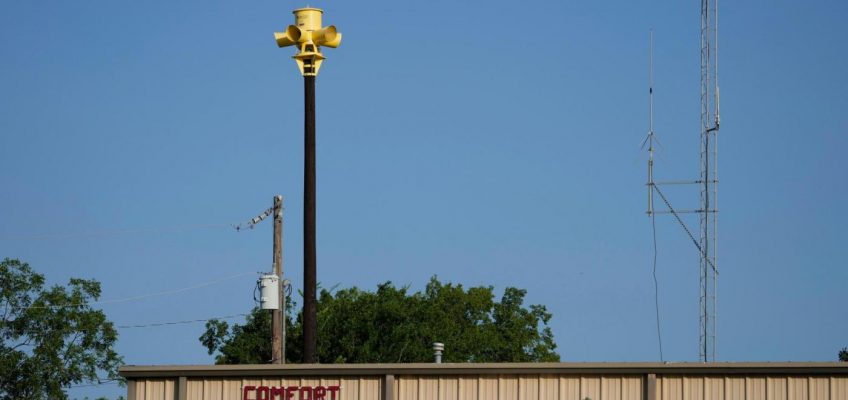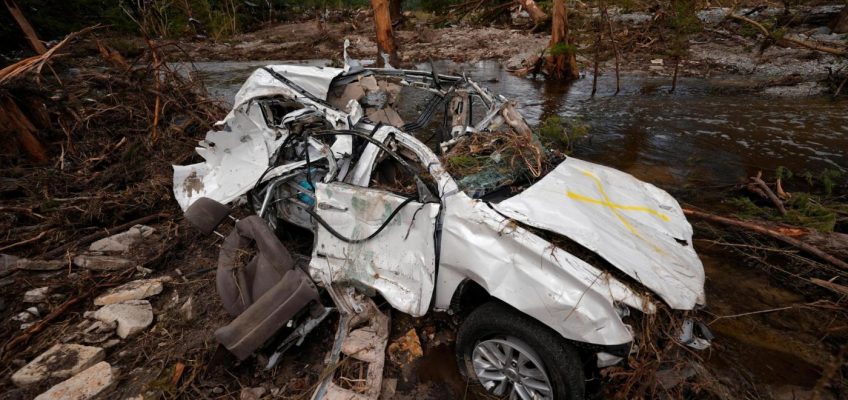By CLAUDIA LAUER
As the Guadalupe River swelled from a wall of water heading downstream, sirens blared over the tiny river community of Comfort — a last-ditch warning to get out for those who had missed cellphone alerts and firefighters going street-to-street telling people to get out.
Related Articles
Gun makers lose appeal of New York law that could make them liable for shootings
US has reclosed its southern border after a flesh-eating parasite is seen further north in Mexico
DACA recipient among those at Alligator Alcatraz, attorney says
Ford recalls over 850,000 cars in the US due to potential fuel pump failure
Freed from ICE detention, Mahmoud Khalil files $20 million claim against Trump administration
Daniel Morales, assistant chief of the Comfort Volunteer Fire Department, believes that long, flat tone the morning of July Fourth saved lives.
The sirens are a testament to the determination of a community that has experienced deadly floods in the past, warning residents of devastating floodwaters that hours earlier had killed at least 118 people in communities along the same river, including 27 campers and counselors in neighboring Kerr County. That county did not have a warning system like the one in Comfort.
Everyone in Comfort, a more than 2,200-person unincorporated community in Kendall County, survived the flooding with many people along the river evacuating in time, Morales said.
Comfort residents were driven by history
Morales has been with the department for decades. He was there when flooding in 1978 killed 33 people, 15 of them in Comfort, including his grandfather. So when an opportunity arose last year to expand the community’s emergency warning system, he and other residents buckled down to find the funding.
The fire department’s siren needed an upgrade. While the firehouse got a new siren, Morales found a Missouri company that was willing to refurbish the old one at a low cost so it could be moved to a central location in Comfort Park where it was connected to a U.S. Geological Survey sensor at Cypress Creek. When the water level reaches a certain point, the sensor triggers the siren, but it can also be sounded manually.
“We do for ourselves and for the community,” Morales said. “If we hadn’t had a drought the past months and the (Cypress) Creek hadn’t been down, we could have had another (19)78. The past few days, I’ll tell you, it brings back a lot.”
Overcoming the cost hurdle for sirens
Morales said they cobbled together money from a grant, from the county commission, the department’s own budget and from the local electric utility, which also donated a siren pole. They also got help installing the flood sensor gauge in the creek.
The price tag with all the donated materials and the costs the department fronted was somewhere around $50,000 to $60,000 or “maybe a little more,” Morales said.
In Kerr County, the price tag for a proposed flood warning system for a larger swath of the Guadalupe River was close to $1 million, which caused several county and city officials to balk when attempts at grants and other funding opportunities fell through. They ultimately didn’t install the warning systems near the camps where dozens of young campers died in the recent flooding.
In Comal County, Texas, about 90 miles east of Kerr County, the Guadalupe River meanders into Canyon Lake before picking back up on its journey to empty into the San Antonio Bay on the Gulf Coast. The county along with Guadalupe County, New Braunfels city government and the Water-Oriented Recreation District- a state-created entity- agreed to fund expanded flood sirens along the Guadalupe River. The project was completed in 2015 and Comal County now manages the system including the information from the river gauges and notifications about the river height. A message left for Comal County officials seeking details about the cost of the system was not returned Thursday.
Training residents was key to success
After the updated Comfort sirens were installed, the volunteer fire department spent months getting the community used to the siren tests that sound daily at noon, putting out messaging that if they hear a siren any other time of day, they should check local TV stations, the department’s Facebook page and elsewhere for emergency notifications.
The sirens make a specific sound for tornadoes and a long, flat tone for floods.
So on July Fourth, if people in Comfort hadn’t seen the weather alerts sent to phones or announced on radios, if they hadn’t heard shouting firefighters going from street to street to evacuate, they heard the long tone and knew they had to leave their homes. A Facebook post on the department’s page noted a mandatory evacuation of all residents along the Guadalupe River.
But Comfort was also miles away from the flash flooding that overtook the camps and didn’t experience the cresting of the river flooding until after the terrifying rush of water in the pitch black early morning hours hit cabins. Many Comfort residents were already awake and aware of the rising water by the time the sirens sounded. The Guadalupe’s crest was among the highest ever recorded at Comfort, rising from hip-height to three stories tall in over just two hours.
Morales doesn’t know if sirens would have changed things in Kerr County. But he knows they gave Comfort residents an extra level of warning. In recent days, Morales said he has been contacted by some of the funders to talk about adding a third siren in town.
“Anything we can do to add to the safety, we’re going to sit down and try to make it work,” he said. “The way things are happening, it might be time to enhance the system even further.”
This story has been updated to correct the name of a county to Kerr County, instead of Kerry County, in the 10th paragraph.
Lauer reported from Philadelphia.




